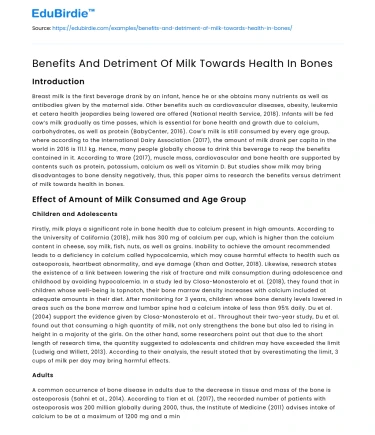Introduction
Breast milk is the first beverage drank by an infant, hence he or she obtains many nutrients as well as antibodies given by the maternal side. Other benefits such as cardiovascular diseases, obesity, leukemia et cetera health jeopardies being lowered are offered (National Health Service, 2018). Infants will be fed cow’s milk gradually as time passes, which is essential for bone health and growth due to calcium, carbohydrates, as well as protein (BabyCenter, 2016). Cow’s milk is still consumed by every age group, where according to the International Dairy Association (2017), the amount of milk drank per capita in the world in 2016 is 111.1 kg. Hence, many people globally choose to drink this beverage to reap the benefits contained in it. According to Ware (2017), muscle mass, cardiovascular and bone health are supported by contents such as protein, potassium, calcium as well as Vitamin D. But studies show milk may bring disadvantages to bone density negatively, thus, this paper aims to research the benefits versus detriment of milk towards health in bones.
Effect of Amount of Milk Consumed and Age Group
Children and Adolescents
Firstly, milk plays a significant role in bone health due to calcium present in high amounts. According to the University of California (2018), milk has 300 mg of calcium per cup, which is higher than the calcium content in cheese, soy milk, fish, nuts, as well as grains. Inability to achieve the amount recommended leads to a deficiency in calcium called hypocalcemia, which may cause harmful effects to health such as osteoporosis, heartbeat abnormality, and eye damage (Khan and Gotter, 2018). Likewise, research states the existence of a link between lowering the risk of fracture and milk consumption during adolescence and childhood by avoiding hypocalcemia. In a study led by Closa-Monasterolo et al. (2018), they found that in children whose well-being is topnotch, their bone marrow density increases with calcium included at adequate amounts in their diet. After monitoring for 3 years, children whose bone density levels lowered in areas such as the bone marrow and lumbar spine had a calcium intake of less than 95% daily. Du et al. (2004) support the evidence given by Closa-Monasterolo et al.. Throughout their two-year study, Du et al. found out that consuming a high quantity of milk, not only strengthens the bone but also led to rising in height in a majority of the girls. On the other hand, some researchers point out that due to the short length of research time, the quantity suggested to adolescents and children may have exceeded the limit (Ludwig and Willett, 2013). According to their analysis, the result stated that by overestimating the limit, 3 cups of milk per day may bring harmful effects.
Save your time!
We can take care of your essay
- Proper editing and formatting
- Free revision, title page, and bibliography
- Flexible prices and money-back guarantee
Adults
A common occurrence of bone disease in adults due to the decrease in tissue and mass of the bone is osteoporosis (Sahni et al., 2014). According to Tian et al. (2017), the recorded number of patients with osteoporosis was 200 million globally during 2000, thus, the Institute of Medicine (2011) advises intake of calcium to be at a maximum of 1200 mg and a minimum of 1000 mg daily in adults. According to Sahni et al. (2014), their research states milk drank at a maximum of 7 cups per week, the chance of hip fracture occurring in adults’ lowers. Also, throughout the eleven-year study, the bone density increased. Therefore, by increasing bone density, the fracture is prevented as well as the risk of obtaining osteoporosis decreases (Guise, 2006). Feskanich, Meyer, Fung, Ferrari, and Willett (2017) supported the study with their positive results. After 32 years, the percentage of hip fracture incidence decreases by 8% with a cup of milk consumed every day in 123906 adults of both genders. Khan et al. (2015) agree with Sahni et al. as their study reported the same result. On the other hand, Michaëlsson et al. (2014) disagree with the evidence given. This is because their study results showed that fracture risk rises when an individual milk consumption increases. They hypothesize inflammation, as well as oxidation, was the causation of an increase in fracture. Cumming et al. (1997) agree with Michaëlsson et al. as their study reported no association between fracture and milk drank.
Conclusion
Overall, milk does increase the prevention of fracture in all age groups despite a handful of studies opposing the conventional idea of osteoporosis risk being lowered through high consumption of milk. Therefore, further studies should be done to prove how much milk should an adult, youth and children consume. In addition to that, the reliability of the study can be increased by considering other factors that affect bone density such as exercise, phosphorus, and vitamin D levels in the body. Both micronutrients affect the concentration of calcium level as well as density of bone (Levine, Rodríguez, Felsenfeld, 2014).






 Stuck on your essay?
Stuck on your essay?

